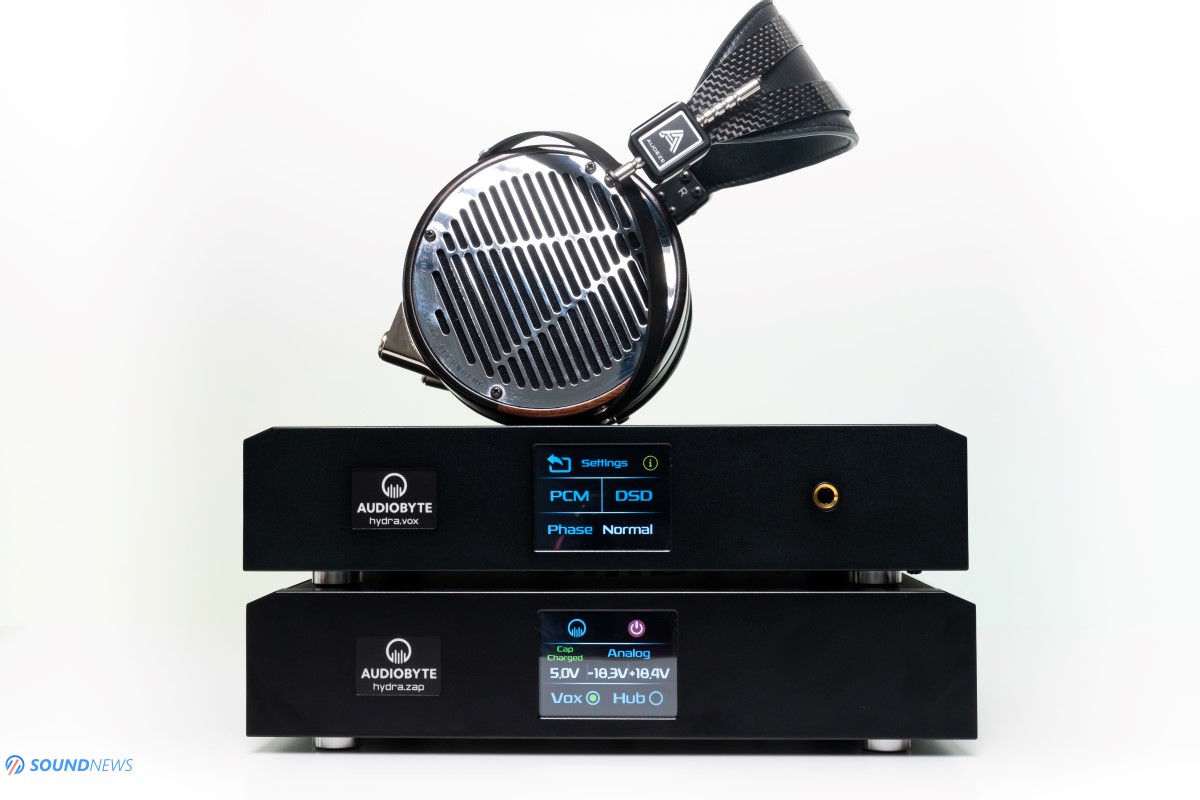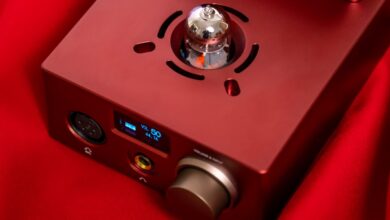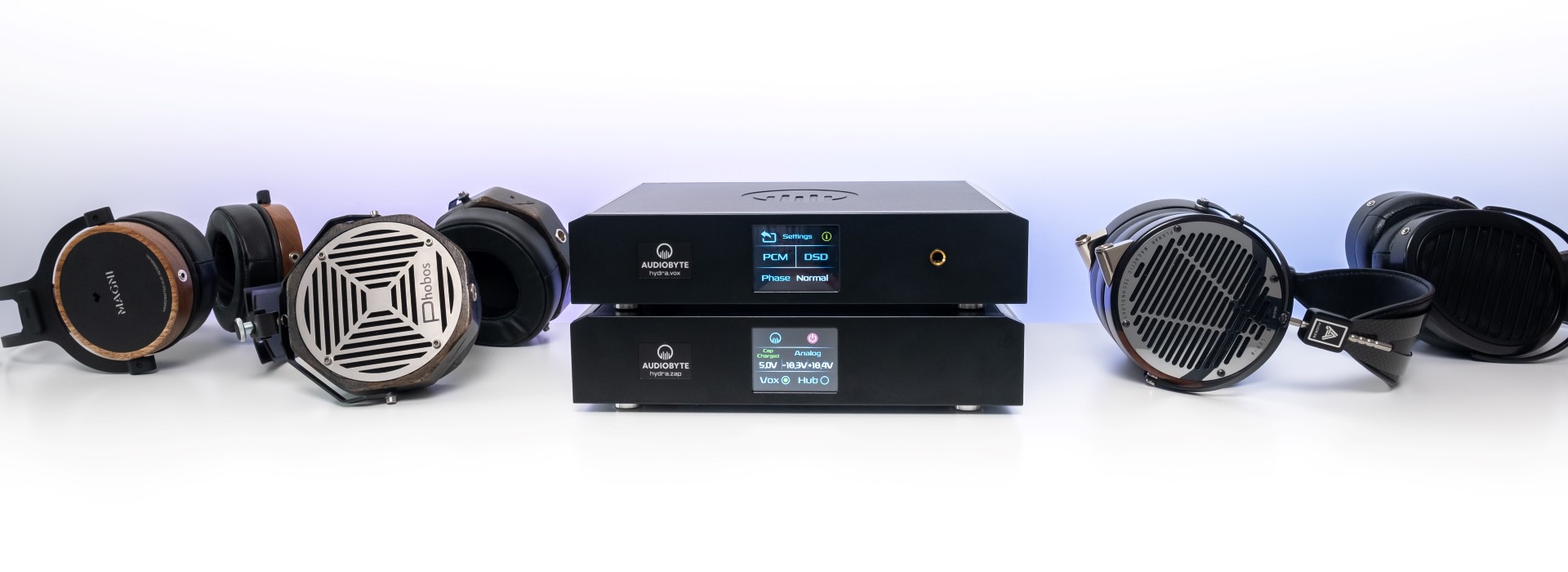
My Video Review:
I just counted that in the last 18 months I have covered slightly more than 45 digital sources on this website, somebody called me DACman privately over social media for obvious reasons. That made me giggle but also question myself if indeed there is a DAC problem buried deep in my subconscious or that that I am simply fascinated by the front-end of all our audio systems. In this period of time, I’ve experienced very few extraordinary sources, a lot of mid-level and entry-level sources, portable and desktop stuff as well. If you would read my latest review of the Musician Pegasus, you would know that I am a lot more excited about complicated stuff, that had long research and development times and that is precisely why chip-based D/S DACs are getting me bored quite fast as of late.
By nature, I am a very curious person and that is why when an audio component lands on my table, even before listening to it, I will pop its case and will try to understand what makes it tick, I would follow the signal path from digital inputs all the way to the analog outputs. I would always seek small pot-holes, mistakes or simple limitations put in place by the cost, by the technology itself, by the development time or by all of the above. After carefully inspecting a unit, I could find rushing, maybe some stolen ideas and rarely a beautiful layout that often times might look like a colorful painting to me, then like a simple green PCB populated with hundreds of components.
There were some really interesting converters in here that made me research more, shoot back and forth multiple emails and listen to music a lot more in the process. However, in all this time, I never actually tested a very modern type of DAC, a very complex unit, with a completely different thinking behind it, that would plunge my curiosity to the stratosphere.
You all know that there are multiple DAC types like Oversampling DACs or interpolating DACs such as those having Delta-Sigma modulators, Binary weighted DACs (like the R-2R ones), there are even Hybrid DACs using a combination of the two. Then there is a new breed of DACs, that recently took the world by the storm and those are FPGA DACs that don’t use DAC chips at all, nor a ladder of resistors, just a silicon that is programmable with custom code that tells it to decode zeroes and ones into toe taps, head-bangs or butterflies in our stomachs. There are quite a lot of such digital creatures, from the likes of PS Audio, Chord Electronics, Tube Technology, Exogal, Meitner, Playback Designs, dCS, Nagra and from a less known manufacturer called Audiobyte.
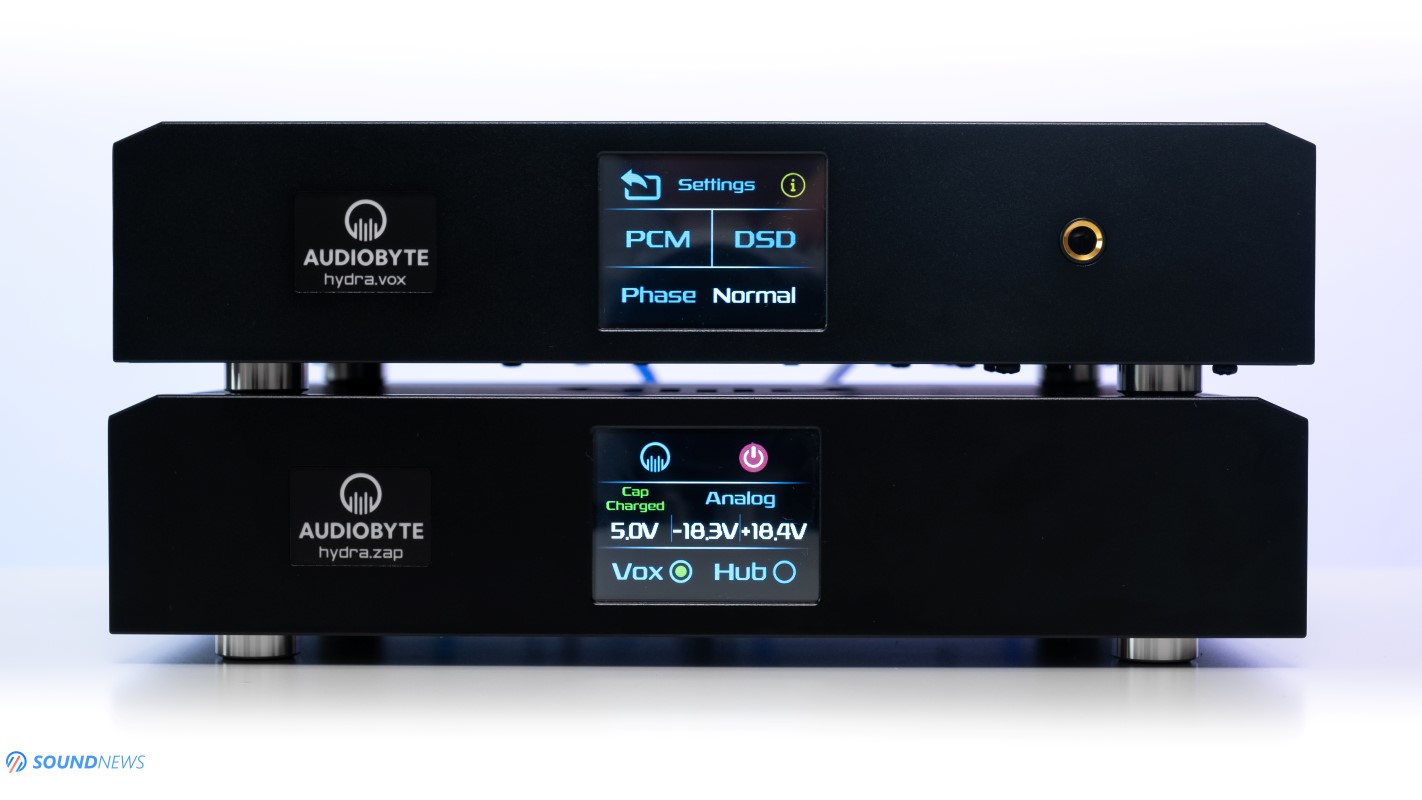
If the latest name doesn’t ring a bell, it is the smaller brother of the high-end Rockna Audio DAC manufacturer from Romania that are currently making one the best R-2R resistor ladders DACs in the world we live today. The founder of Rockna Audio – Nicolae Jitariu or as close friends are calling him Nucu, is obsessed with digital audio. Before Nucu created Audiobyte, there was another sub-brand of his called AD-Labs. My very first DAC I ever used was an AD-Labs RD-2 that was sold in two versions: a final assembled product in a metal case and a DIY version without the metal case. Being a student at that time and having close to zero income I went with the PCB only version. I still have very fond memories of that unit, it didn’t have a metal case so I put it in a card-board box with some tinfoil wrapped around it, it looked more like a DIY bomb that you would make in a cave, but it sounded like a diva to me and that mattered the most to me. It was connected to a CMOY amp (remember those?) that I soldered myself and I was driving some Amfiton TDS-15 planar headphones and later on some uber high-end (at that time) Sennheiser HD580. That happened about ~16 years ago, how time flies…
As you can imagine, Nucu is not new to this game as Rockna Audio, AD-Labs and Audiobyte are true testaments to his commitment and to his very different way of thinking. Most people are idolizing dead men that lived thousands of years ago, but I’m idolizing bright minds of the digital audio world and I consider him one of the best ones, who is not following the trend but instead decided to make different, complex, unique and epic sounding audio gear. Today, I will be testing his newest creation from the Audiobyte sub-brand that is called HydraVox (Vox from now on) – it’s an 1bit FPGA DAC and headphone amp/preamp combo that is being driven by the HydraZap (Zap from now on) power supply.
The Hydra name was already used few times by the Audiobyte team, I personally owned their first creature called Hydra X+ and even made a review for it back in the day. Later on, Audiobyte released one of the best, if not the best USB Audio playback bridge and clock generator called Hydra-Z that could be improved upon with their ZPM ultra-linear power supply. Some still consider it the very best USB to S/PDIF interface that money could buy.
The Hydra family recently increased its numbers with the release of the HydraVox, HydraZap and very soon with the HydraHub digital audio transport / streamer / reclocker and upsampler. We can’t stop the rise of the Hydra, so I just will whisper it quietly: Hail Hydra!
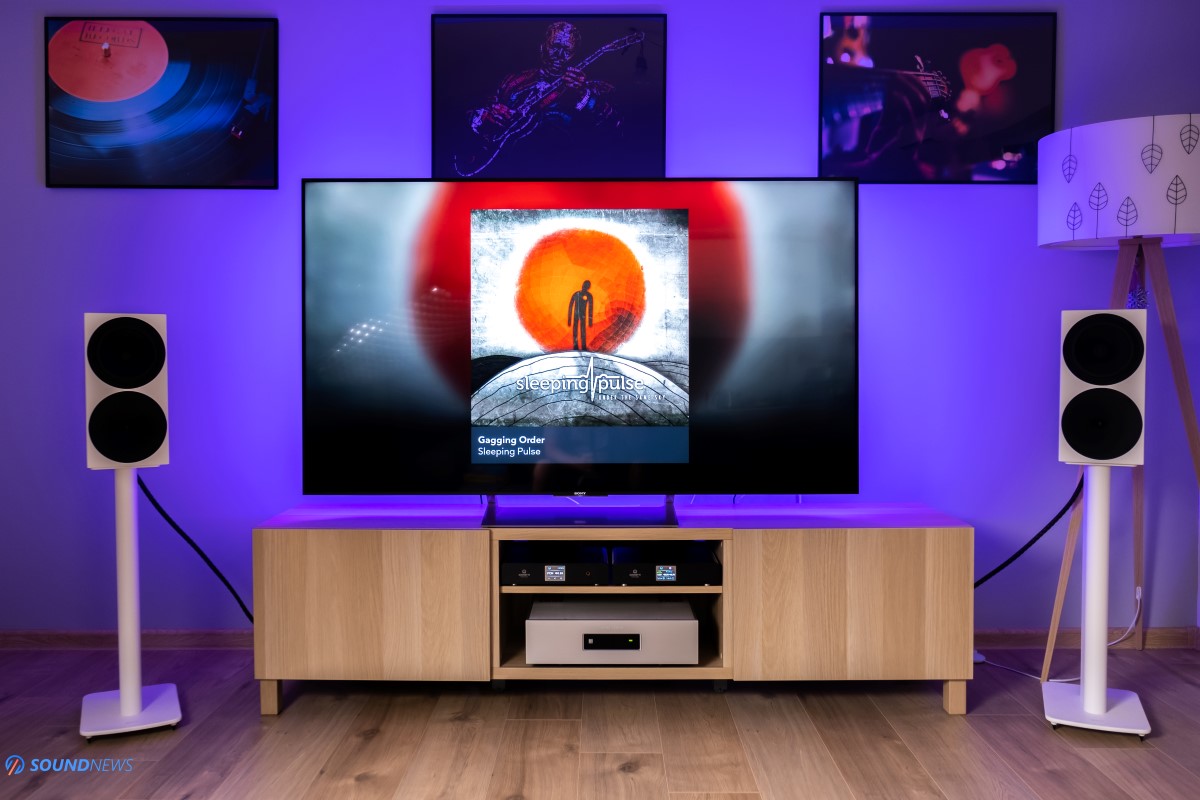
Q&A Session with Audiobyte
HydraVox sparked my curiosity so much, that I felt the urge to ask some tricky questions to its creators and I’ve got some really interesting answers, so let’s check them out:
Sandu V. (Soundnews) Q1: Can you tell how it all started, what was the spark that ignited the fire?
Nucu J. (Audiobyte): There were more sparks, not just one… it was a class A amp that I built, ages ago, then a CD player that I had which rocked my world in terms of digital playback (by yesterday’s standards but was a real eye opener). At last, I was crazy enough to start a commercial venture in high-end audio. You know what they say…”how do you make a small fortune with audio?” …”start with a big one”..:)
Q2: Why did you choose Rockna and Audiobyte company names?
Nucu: Choosing names is a daunting task 😊 Rockna represents solidity – “rock” and a certain type of music or mood…also starts with “RO” which is acronym of my country’s name. Audiobyte comes from the joining of the words audio and byte (8 bits) – the heart of digital reproduction.
Q3: When you first started Rockna 20 years ago you were developing mostly analog only devices like integrated, preamps and power amps, nowadays you are making digital only devices. Are you considering going back to your roots making high-performance Integrated, preamps and power amps again?
Nucu: Frankly I am thinking about that each and every year, but it is hard to find the time when involved into the moving sands of the digital domain. Probably we will release at least a statement amplifier at our 25th anniversary.
Q4: I always scratched my head with this one: why two companies? Why Rockna and Audiobyte and not just a single brand? You need twice the work with marketing, advertising, social media, brand identity, not to mention research and development costs.
Nucu: On one side you are right, there is “double trouble” but I always felt that I have to access the market from 2 or more directions. Audiobyte and Rockna are quite different products as technology, form factor and cost. They address different customers with different needs.
Q5: I personally daily encounter “me-too” products in the digital or analog audio world. Your audio components are like a far cry from the sea of me-too products and offer something others didn’t think of. Was this born out of curiosity, ambition, a little bit of madness or you just wanted to be different? If it was something else, can you enlighten our readers/viewers?
Nucu: This is the expression of what we are and probably a little bit of all things mentioned. Our approach of the products are technically elegant and satisfactory solutions that represents our core values. When I look into a product I want to be impressed; not only by the build quality but also by the internal architecture and practical solutions. This is why we spend so much time and effort with research and development.
Q6: I understand that making 100% custom R2R modules and 1bit FPGA software defined DACs is a very tedious and time-consuming process that can last years to perfect. Did you ever felt abandoning those projects and moving on to consumer grade DAC chips? How many revisions some of your D/A converters had, can you give us an example?
Nucu: It is true, mastering D/A conversion is not for the faint of heart 😊 it is time consuming, different angles approaching adventure where you fight saga’s with creatures like noise floor, THD, linearity and so on. Sometimes, these creatures work together against you – you kill one but another becomes bigger. But in the same time, you are touching the core of the sound reproduction and you are playing with it – which offers a great satisfaction. For this reason, we sometimes go through tens of revisions before product launch. And no, I am not tempted to go back. I just want to improve what we already did, or find new and more innovative ways to do it. Anyway, there is more than digital to analog process itself; equally challenging are the front-end and clocking systems.
Q7: You seem to have a cult-following in the Asian market, I am right to believe you are delivering more products to the Asian market than the rest of the word? If that is the case, is there an explanation for that phenomenon?
Nucu: Perhaps Asian markets were more open to brands coming from Eastern Europe a few years ago. Now the situation is somehow balanced, possibly our brand awareness has raised a bit in the past years worldwide. About cult-following, I don’t know, we are thrilled when we can produce musical joy but we stay humble and keep improving what we do.
Q8: Headphone market skyrocketed in the past 10 years or so and it doesn’t want to hit the brakes. Black Dragon already had a dedicated headphone amp and I’m sure lots of folks are loving it dearly. Is the HydraVox a spiritual successor to that one or it is a complete re-design and a much higher-class device?
Nucu: Vox decoder and amplifier parts are done from scratch – there is no link between it and Black Dragon. I wish I could have more space and more heatsinks on the Vox so we could throw a bigger headphone amp inside – but I think we got good performance using the space available.
Q9: Do you plan any smartphone integration for your newest products? Fresh and young audiophiles will love that.
Nucu: Well, we already did some steps in this direction. Both Rockna and Audiobyte have some products that have remote controls replaced with control apps. Got some emails at first “could not find the remote inside the box” but hey, we have to move forward 😊
End words: Thank you for starting Rockna, Audiobyte, for thinking different, for your ambition, for your existence and thanks for accepting in answering my Q&A session!
Nucu: You are most welcome! I am thankful to all audio community and equally to all Rockna & Audiobyte teams which made this endeavor possible.
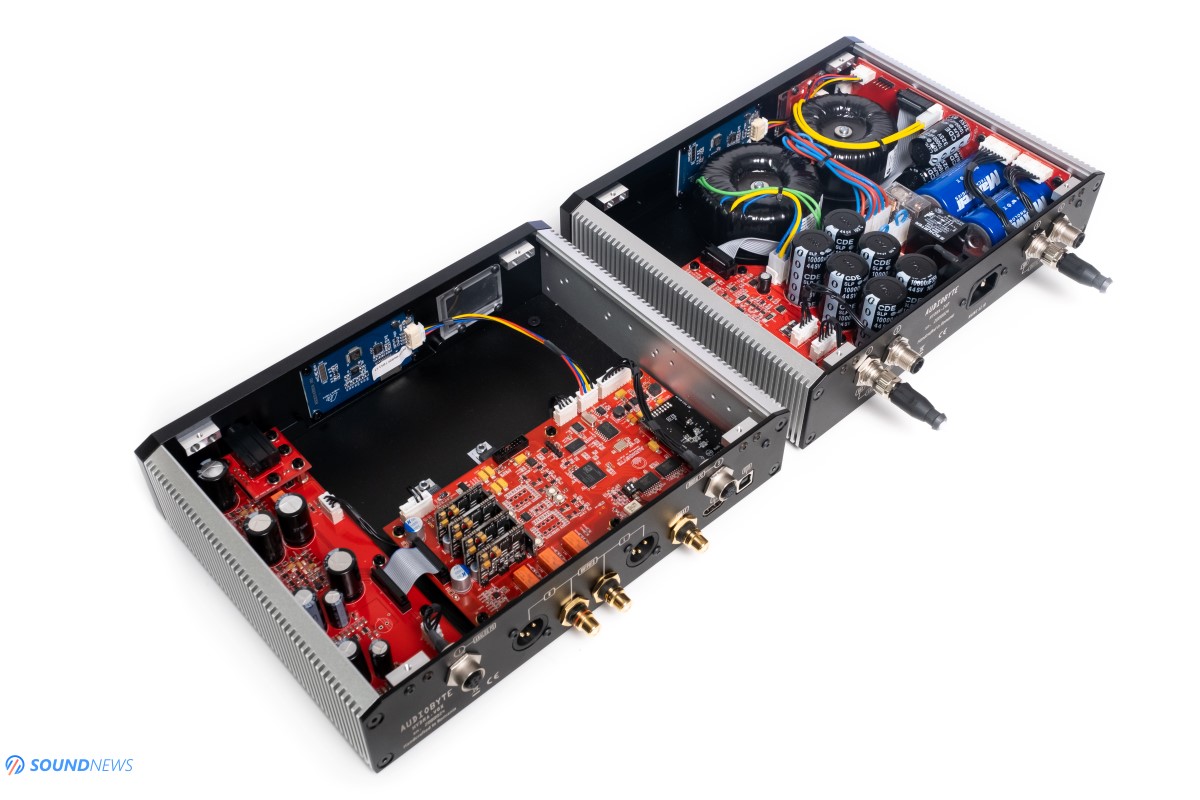
Unboxing Experience
The combo came in two separate boxes, much bigger in size compared to regular boxes that I am normally receiving, already suggesting that Vox and Zap are one the bigger and heavier side of things.
Inside the package there is an unhealthy amount of hardened foam as extra protection measures. Both units are sitting in a carved spot completely surrounded by that foam, so you can be sure that both units will arrive safe and sound at the front of your door.
Vox is coming with two umbilical cords, about half a meter each, pretty nice quality ones if you ask me. You will use them to connect the digital section and the analog section separately to the Zap ultra-linear and smart power supply. Zap is coming with an AC cable instead and that is basically all you can find in the package. My particular unit didn’t come with a user manual, if you need one you can download it from here. Before connecting the unit to your PC, please install the USB drivers first, you can download them from here. Hydra combo didn’t come with a remote control, before you get sad, you can download the Hydra Remote app from Google PlayStore from here that will transform your smartphone into a clever remote for the Hydra all-in-one combo, I’m liking this feature quite a lot especially when I’m using it as a DAC + Preamp in the living room or when I’m far away from it, sitting on a sofa with headphones of my head. iOS app is coming soon too, stay tuned for that!
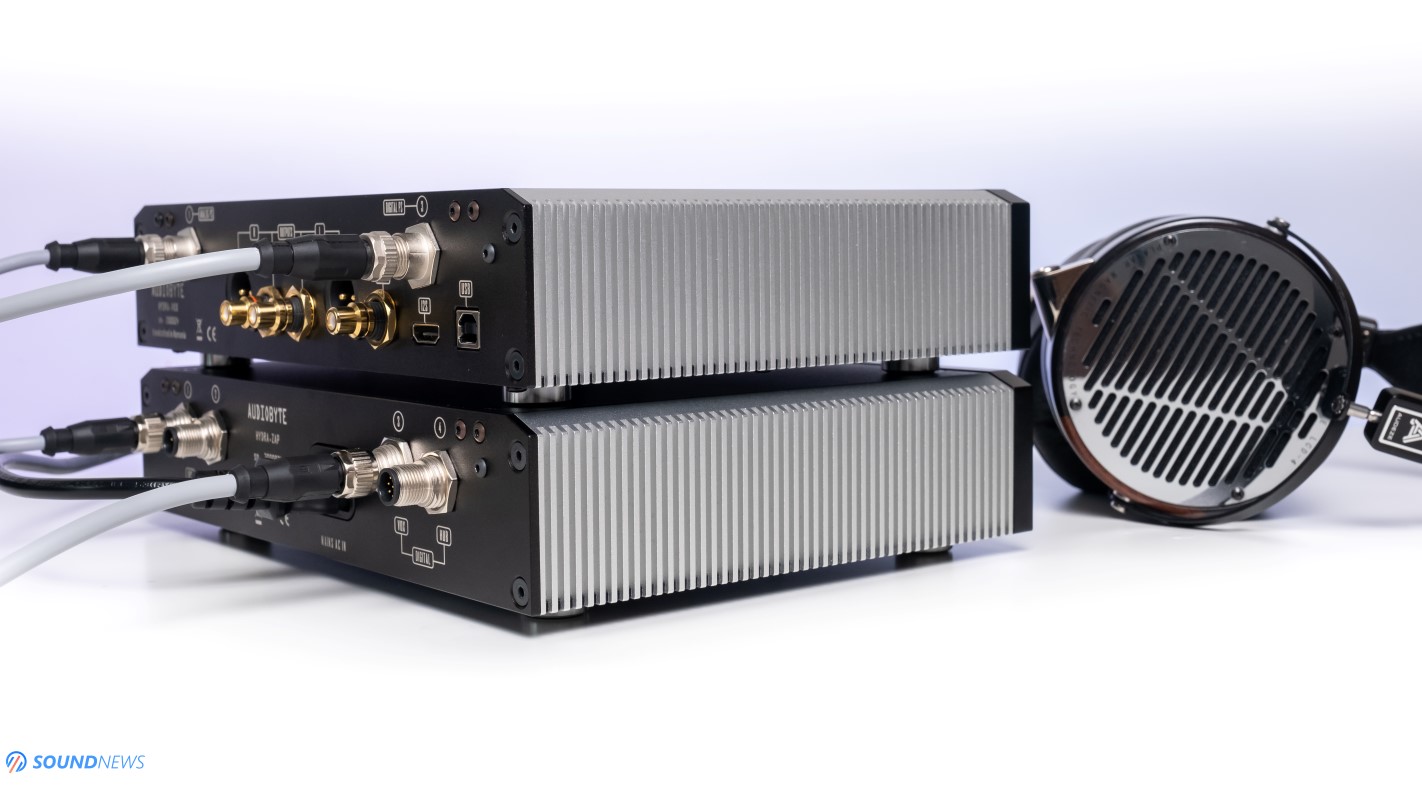
Design & Build Quality
This is what I call a very polished device from any point of view, it looks serious and very pleasing at the same time. Both units are made from thick machined aluminum, I really dig the Audiobyte logo carved on top of both devices. The silver aluminum fins are working as massive heat sinks, dissipating all the heat accumulated inside. Both units are getting quite hot after few hours of use, so I’m recommending leaving both in a well-ventilated area. You can stack them one on another, I actually used them this way more often and I had no problem with the heat for more than 2 weeks while using this setup. With that said, I don’t recommend putting another hot unit like a headphone amplifier or an integrated amplifier directly on top of the Vox, just to prologue the life of all the electronics inside it. With gear at this caliber I would put them on a rack, on different levels for even a better heat dissipation.
Build quality is simply immaculate and there is really nothing to complain about both units. The industrial modern look is attracting a lot of eyes, especially after seeing both touch-screens in the middle and those interesting digital VU-meters when checking the power supply of the analog section (Analog Monitor). The front plate has a thickness of about 1 cm and the lateral heat sinks a thickness of 1.3 cm, so you can be sure that both units are protected from any wireless interference.
I find the front panel quite sexy, there is only an LCD touch-screen in the middle, a 6.35 (1/4”) headphone socket on the right, an Audiobyte logo on the left and that is basically it. No volume knob, no metal switches, not a single button, screws or anything else. It looks neat, yet elegant and I quite like that.
I appreciate putting high-quality metal feet under both units that are actually placed in small cut-outs carved in the case itself. Each metal foot is surrounded by a silicon O-ring that will absorb small vibrations and make both units perform at optimum parameters.
There are a lot of other small details that you can observe only after closely inspecting both units like laser engraved logos on the back, everything is perfectly aligned like the analog outputs or the umbilical cables to/from the power supply. There isn’t really a lot more to say about its look, it has a modern and very durable case with a high-end flare attached to it.
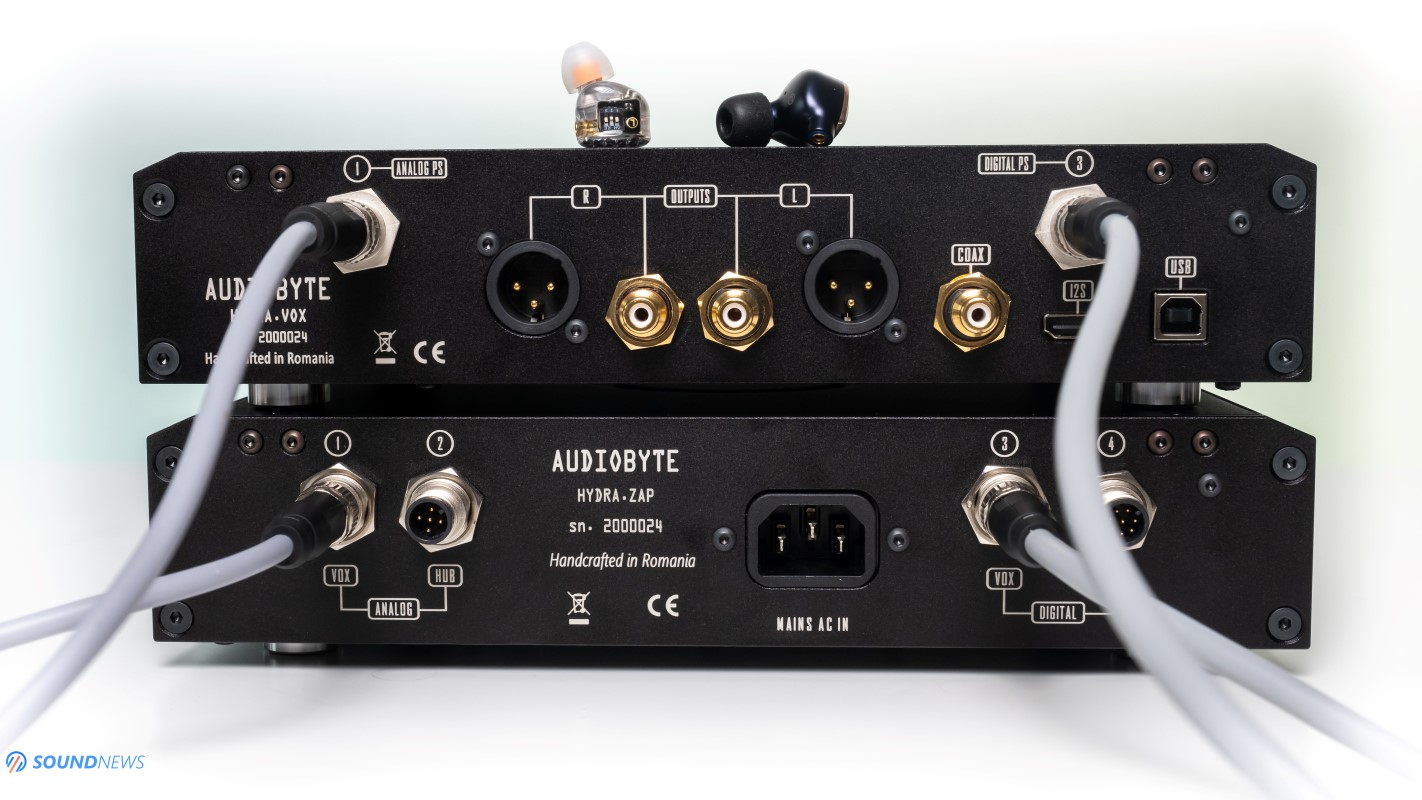
Controls & Connectivity
The star of the show is actually those two touch-screens in the middle that are adding a lot of value to this combo. You can control a lot of things from there, the power supply is also showing a lot of important stuff, you can even check individually the analog and the digital sections of the power supply. I never saw anything like it and the attention to detail is mind-boggling.
With a simple press on the Zap touch-screen, it will power on the Zap and after the internal ultra-capacitors are charged, it will turn on the Vox and it can also power the HydraHub later on, after it will hit the market. When Vox is powered, you can change manually the volume of the headphone output, when headphones are not attached you will be controlling its preamp output, you can also do that via the Hydra Remote app. The Vox employs a high-performance headphone amplifier, it is a single ended one so a single 6.35mm (1/4”) headphone jack can also be found on the face place.
Taking a glance on the back you can spot 3 digital inputs as Coaxial, USB and I2S and two analog outputs as RCA and XLR. Vox is powered by two umbilical cords that are carrying clean DC power from the Zap power supply. You need only a single AC power cable to power all 3 units. The analog and digital umbilical cords are having different pin configurations, you cannot interchange them so sleep tight my OCD friends.
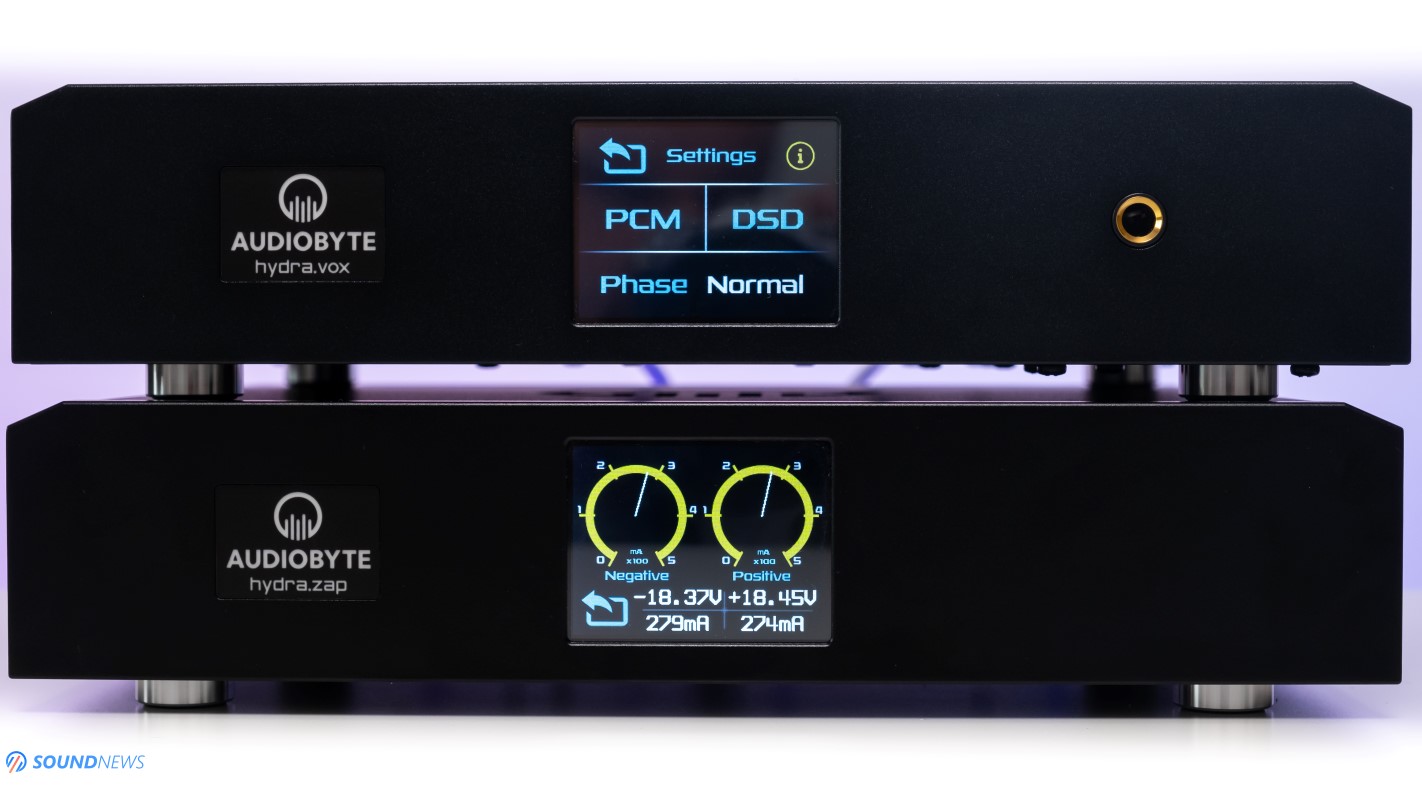
Menu Settings
Vox and Zap combo are using one of the most user-friendly interfaces that I have used in a DAC, I mean I didn’t test a friendlier unit up to this point. Only after an hour or so, everything becomes clear and very easy to use. Unlike a lot of companies from the land of the Red Dragon that use very complicated user menus (like SMSL and Audio-GD), Audiobyte went in the opposite direction with a smartphone like look and approach.
By default, the Zap will show on its screen the power consumption of both the digital and analog section of the Vox: 5V for the digital section and the analog section is set somewhere around ~18.3V. You can check individually the Digital Monitor or the Analog Monitor, the later one looks really cool with some old school VU-meters on the screen.
You can even manually adjust the Voltage output for the secondary output (Zap has two analog and two digital outputs) ranging from 12 V up to 21 V just in case you’ll want to use the Zap with something else that can accept this DC voltage values, but you will need a custom cable for that.
The Vox by default will show on its screen the data stream as PCM or DSD, the sample rate, the volume position and the selected digital input. A simple touch on (-) or (+) will increase or decrease the volume, the upper right corner will toggle between 3 digital inputs and the upper left corner will let you choose between normal or inverted phase, the PCM phase response with 3 different positions and some interesting DSD setting. When you enable DSD Direct, the volume becomes fixed at maximum and the headphone output will be disabled. In this mode it will directly convert DSD256 / 512 signals, bypassing all internal processing. This feature is possible only via USB and I2S. If you are one of the HQplayer or Jriver Media Center users that are using software to convert PCM into DSD in real time and then send all that data as DSD directly to your DAC, you should know that Vox is doing that on a hardware level and not on the software level. If you want all your music to sound like digital vinyl, then there isn’t a better DAC that can do this. This is one of few DACs I know of, that is doing this on the hardware level and I can only congratulate the Audiobyte team by thinking out of the box.
At this moment Audiobyte is also developing 3 very distinct sounding firmware versions, first one was called Rocket, now by default it is coming with Bullet, the next one called Torpedo is being developed right now, each one with its own sub-versions so you can tailor the sound exactly to your needs.
Technology Inside the HydraVox and HydraZap.

I. HydraZap
When you give an actual name as HydraZap to your power supply, you know that is not your regular and typical power supply, it’s something else and after closely inspecting it, you are starting to realize how clever and smart it was designed.
For example, when you use the Hydra Remote app, the Bluetooth chip that establishes communications with your smartphone is located inside the Zap and not in the Vox, why you might ask? To completely null any wireless interferences with the Vox, a very clever design decision!
Zap is an ultra-low noise power supply for the Vox and Hub with symmetrical analog, digital and reference voltages. The digital section as an ultra-capacitor based, low impedance power supply. It features a capacitor bank of 2 x 310 F, if you want that in µF (microFarads) instead of farads as most of audio manufacturers will provide, then that is exactly 2 x 310.000.000 µF and yes, you read that right.
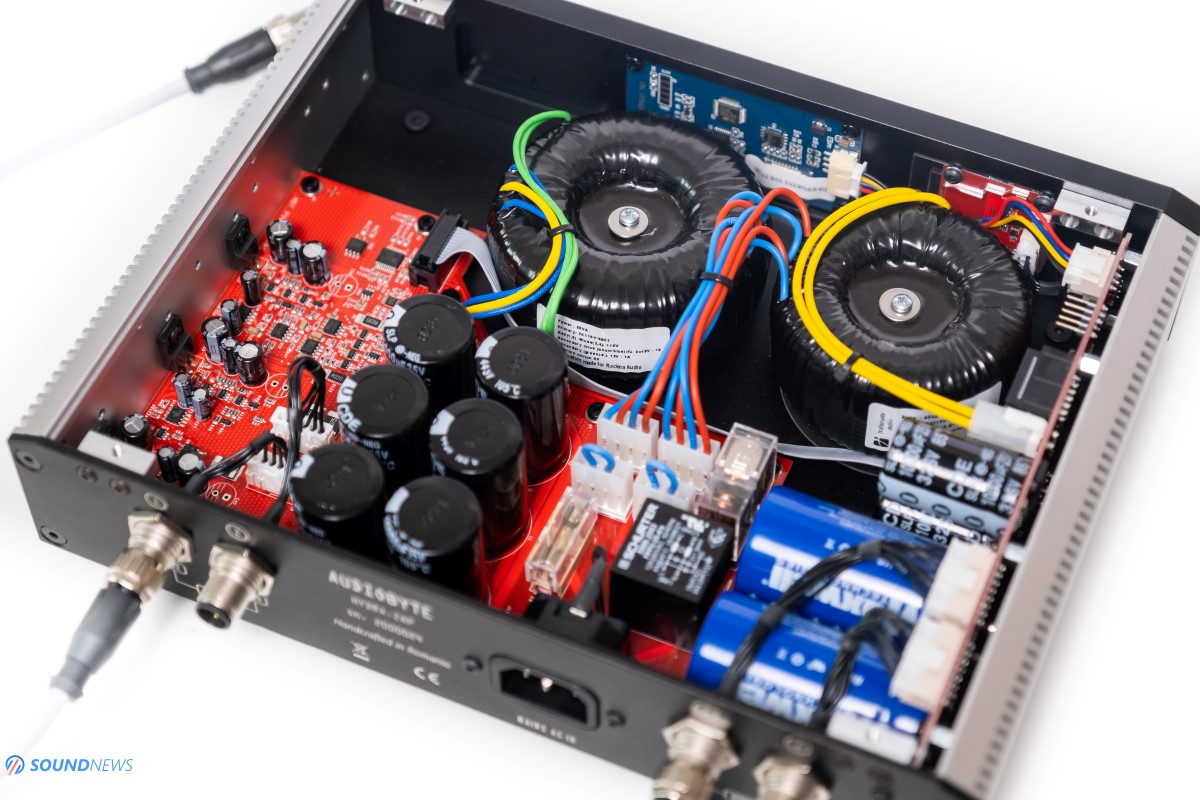
When you power the Zap for the first time, it will start charging those ultra-capacitors before powering the Vox, that process could take a few minutes, up to 2 hours (if the power bank is completely empty). The charging process is seamless and it is microprocessor controlled with progress tracking on the Zap display. The digital power supply of the Zap will power only the digital side of the Vox and Hub. Once fully charged and left connected to mains in the stand-by mode, a single touch on the ZAP touch screen will power up the VOX instantly, that would happen every single time you are ready for some jamming.
The analog power supply is using adjustable discrete regulators, yes adjustable, meaning that you can manually adjust the voltage output ranging from 12 to 21 V just in case you’ll want the Zap to power an additional unit that is not part of the Hydra family. How cool is that? Those discrete regulators are shunt mode high rejection based on proprietary Audiobyte technology. The analog power supply will power only the analog side of the electronics, like the output stage of the DAC, the preamp and the headphone amp. It will also show all voltages and current consumption in real time on its display which is kind of neat to look at.
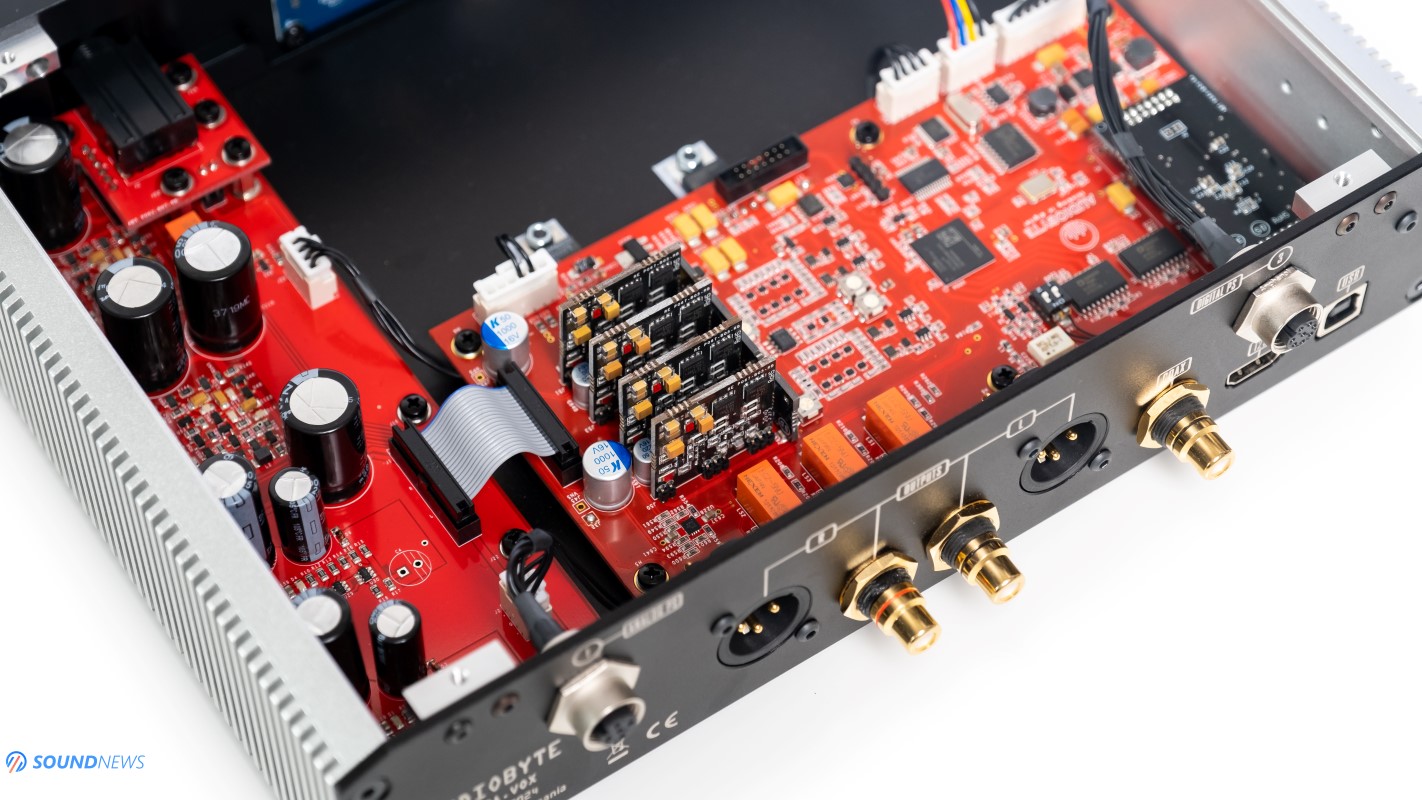
II. HydraVox
Most important part of the Vox is its DAC section, which I consider special and unlike anything I’ve tested until this point. Vox doesn’t have any commercial DAC chips inside, it doesn’t have an R-2R ladder of resistors, instead it has a Xilinx 7-Series FPGA (Field Programmable Gate Array) inside that was programmed to do all the heavy lifting. This is very much a software defined DAC, meaning that with firmware updates you can actually change its sound signature and even improve some of its specs on the hardware level.
The architecture is pure 1-bit, meaning that all incoming sample rates are converted inside into DSD256 or 512 depending on the firmware, after which the analog conversion is done using current segment technology. When you want to have a really high-end sounding unit, the internal processing must be done at a higher resolution than that of the music that is being decoded, so using 80 DSP cores all running at 200 MHz that equals to 68-bit processing, VOX has enough computational power to preserve the transparency at its purest form.

Audiobyte team also incorporated a very advanced Phase Correction system based on FPGA digital filters that are programmed to exhibit a mirrored (complementary) response with phase error given by analog circuitry – completely cancelling the phase errors at the output. It will result in a perfect phase response over the entire audio band! Clever, neat and impressive.
We all know that a high-end DAC will need some of the best clocks to unlock its full potential and that is precisely why Vox is using a proprietary FemtoVox clocking system using a high-quality DPLL clock generator with a jitter rejection architecture. This design, does not require an ASRC (Asynchronous Sample Rate Converter) for the purest possible signal.
The output stage or analog buffer stage as Audiobyte is calling it, is using only low noise bipolar discrete devices. I see exactly 4 circuit boards for the analog buffer stage, meaning that Vox is a fully balanced DAC.
Vox is also employing a high-performance headphone amplifier and it actually takes almost half the space inside its case. The headphone amplifier is also using only discrete components as bipolar transistors, I counted 6 of them which are directly bolted to the heat sink to cool down. Audiobyte went completely all-in and put all the best components you could desire as Nexem relays, Tantalum capacitors, Rubycon filtering caps and other exotic stuff that you can’t find in a typical DAC + Preamp + Headphone amp combos.
As for its volume control, the internal 35-bit data path uses a very high quality 32-bit volume control, meaning that it can directly drive a power amplifier. Vox can output 3.8V on both the RCA and XLR and 9V of the headphone output, if you want that in Watts, that is 3 juicy Watts into a 16 Ohm load.
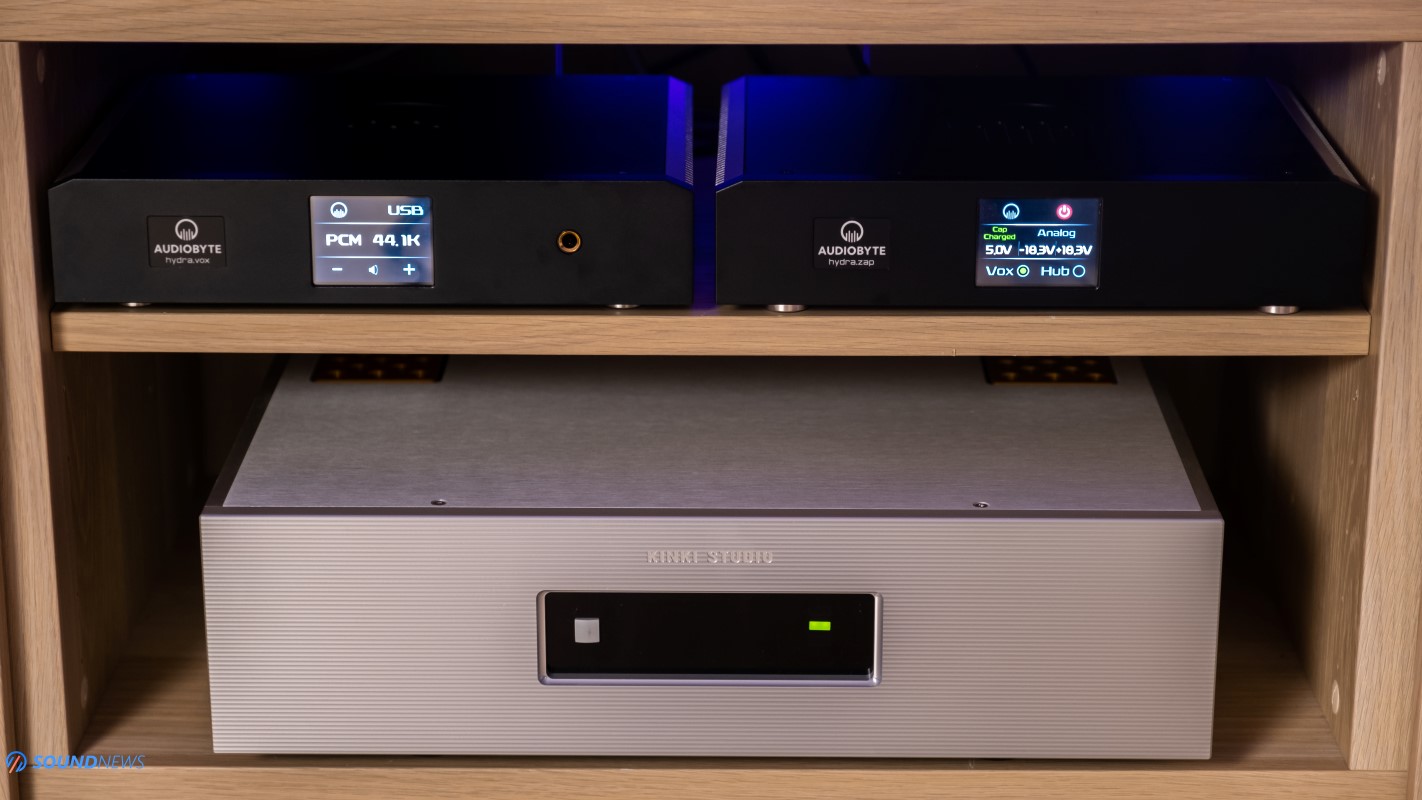
Test Equipment
HydraVox stack is targeted as a high-end desktop solution for your TOTL headphones, but also as a top DAC + Preamp unit that can be used with your loudspeakers and as such it was used in two very distinct setups:
- I used it the most in front of my PC, driving directly 8-pairs of headphones, from which 4 can be considered as high-end cans. I wanted to analyze how powerful is the headphone amp section so planar-magnetic headphones were used the most. I also connected it to the Benchmark HPA4 just to find out the exact tonality of its internal headphone amp section.
- Since it can drive directly a power amplifier, I also moved it to the living room where it was driving directly a KECES S125 and a Kinki Studio EX-M7 power amplifier, followed by some Buchardt S400 loudspeakers.
Ok everyone, my body and soul are ready for some well-deserved music, so I will just close my eyes, lean back and enjoy some high-quality time with it.
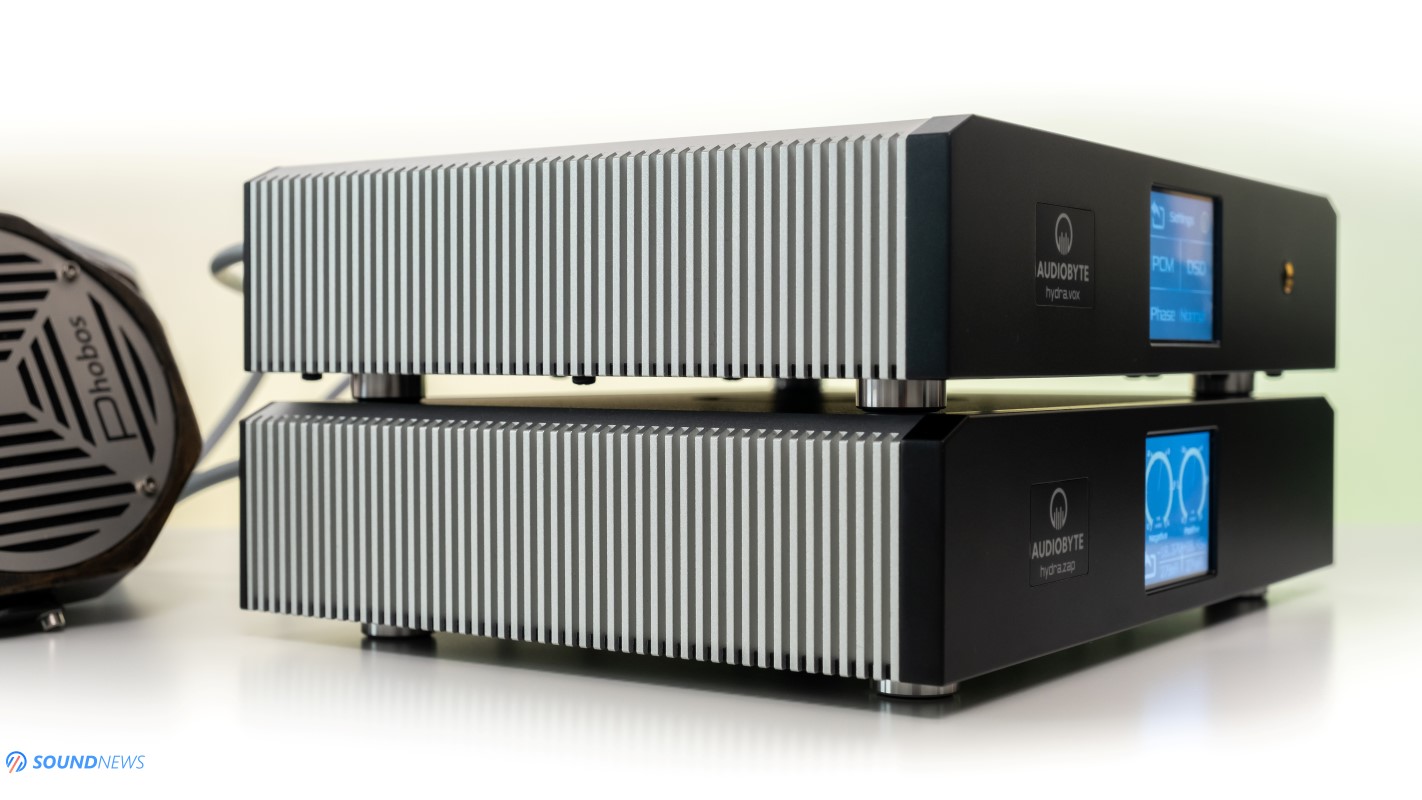
Sound Performance
I. Preliminary Impressions & Tonality
After an agonizing full week of waiting for some burn-in, I finally picked a pair of Audeze LCD-4, I sat and listened for about three hours straight! Three hours of smiles, of goose-bumps, but also leaving me lots of questions after that. Some of you know that I am not that big of a fan of the Chord Electronics stuff, I’m yet to hear their higher-end offerings that might change my mind. Chord are also making FPGA DACs and yet those sound so different to the HydraVox that I don’t have enough words to express my surprise.
Vox doesn’t want to impress with over-sharpness, with over-detailed leading edges, with a forward midrange and on-stage presentation, Vox is anything like that. Instead, Vox will throw a simply massive stage in front of the listener, it will expand it in all possible directions, it is really something else. Even with headphones it becomes very apparent from the first seconds of pressing play. When I first received it, I decided to listen to it for few minutes even without any burn-in and I’ve experienced a very voluptuous sound, much heavier in tonality, it had a lot of bass and midrange presence and the overall pace was slower than usual. Few days later and it started opening-up, treble made its appearance a lot more, bass become considerably tighter and much faster compared to few days ago.
After one week of burn-in, it sounds nothing like my first impression, biggest change was felt in terms of speed, openness and of course details, lots and lots of details came in towards me. While I am listening to anything via this combo, it reminds me a lot about live music, about music as an act of pleasure and not like a decoding process is going underway.
You know, there are DACs that can appear as dark or bright sounding, others are putting an accent on treble, others will apply a smoothing filter over your music, some might have a clear leading edge but a hollow texture. Vox is more like the real thing, nothing is standing in its way, with no particular highlights to mention and yet everything is exactly at its right place. It knows how to accelerate those dynamic swings, so when a note crashes on you, prepare your chest and eardrums, as Vox clearly knows how to land punches in terms of transient response. It is also extremely textured as music doesn’t feel hollow inside anymore, like some D/S DACs are doing. It has a lot of meat to the bone, a lot of boldness and a lot of substance that sincerely a lot of DACs are missing nowadays. Vox doesn’t impress you right away as others are doing with some tricky DSP, it will impress you only in the long run. The more you listen to it, the more you start realizing that bass becomes deeper, clearer and more authoritative, midrange becomes natural and soul-grabbing to a point of challenging the best R-2R DAC I’ve heard so far. Treble is extremely textured, so much so that it matches or surpasses the treble performance of the best D/S DACs, but without a sharpness filter all over the highest registers as the latter ones are doing.
Vox sounds like when I’ve listened for the first time to a really nice DSD album decoded natively, I felt that eerie bonding of all the musical notes, that invisible smoothness, that black background with notes born out of thin air is exactly how it sounds all the time. The digital glare that plagues so many albums and a lot of DACs is nowhere to be found as Vox is simply the definition of music in its purest form.
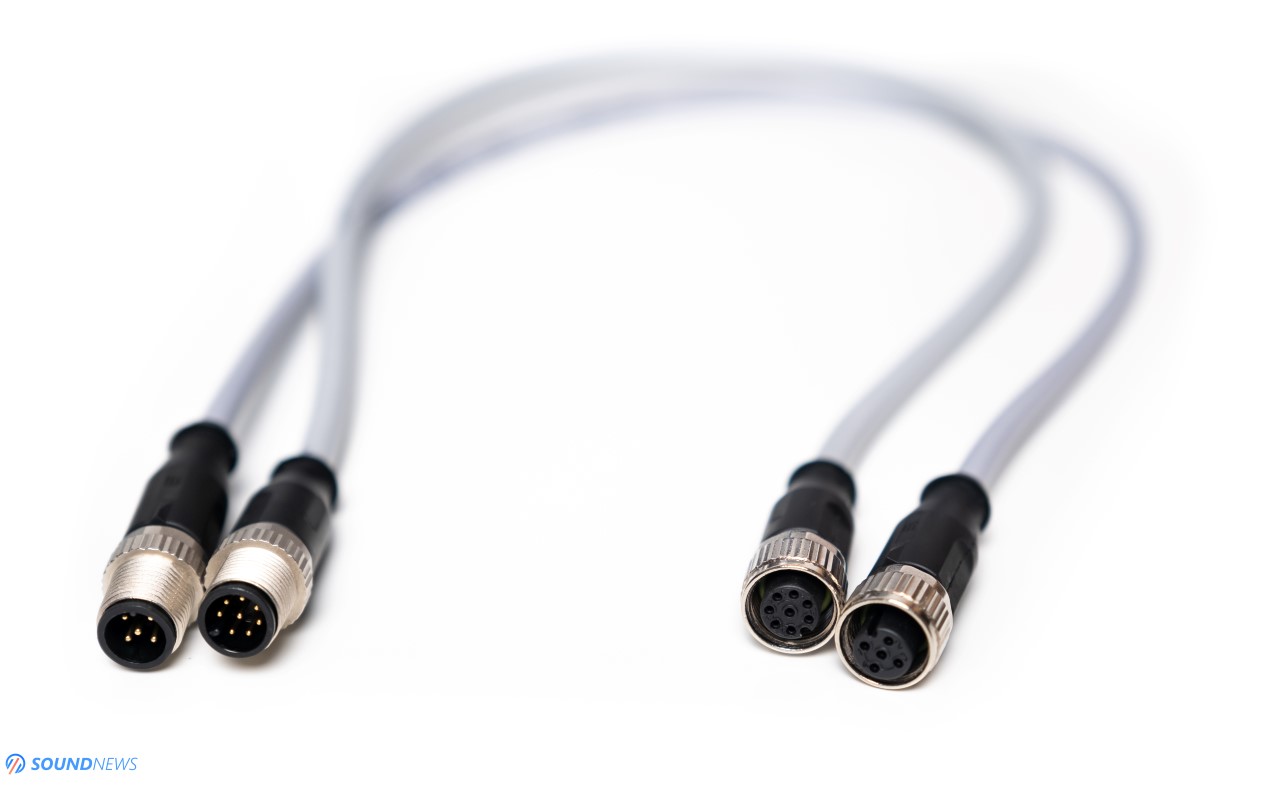
II. Background Noise & IEM compatibility
I will split this chapter in two, as I will test its noise rejection performance in a speaker-based setup and then in a headphone setup. Driving the KECES S125 power amp and then trying that monstrous 25-kilo Kinki Studio EX-M7 power amp was an easy task for speakers like Buchardt S400. Generally speaking, on the XLR out the Vox is completely noiseless, no matter the volume that is being played and no matter the song, I didn’t encounter hissing, stutters, disturbing noises, nothing like that. S400 is quite a sensitive loudspeaker so it usually picks up residual noise of the lower quality sources as that happened multiple times already. Vox will not put nasty gremlins in your music and in terms of blackness, it can’t be blacker than that.
Switching to the headphone output with all desktop headphones, including with the 20-Ohm Quad ERA-1 and 35-Ohm Hifiman Arya, the background again appears as clean and as dark as it was on speakers. I went again through a couple of tracks and I have really zero complaints. Dynamics are swinging in full-force, music is hitting me hard, I’m headbanging with a huge grin on my face, meaning that everything is exactly where I want it to be. Even going as loud as -8 dB, everything seems super clean, defined, it is not losing any detail or crispness. In this regard, it behaves exactly as a high-performance Class-A desktop headphone amplifier, so no complaints here.
Only when I switched to the most sensitive In-Ear-Monitors as FiiO FA9 and FH7, no matter the volume level, be it the lowest or the highest, there would be a very faint and barely audible low-intensity hum all over my music. If I would hit play, I could not spot it anymore but when I’m pausing my music, I can hear it in very small doses. In its defense I will mention that all bipolar resistor based desktop amplifiers that I have tried like Audio-GD D28, Audio-GD Master-9, Burson Conductor 3 Reference, Kinki Studio THR-1 and Flux Lab Acoustics FCN-10 all had the same issue, offering lots of power for harder to drive headphones, but a bit of residual noise with the most sensitive IEMs. You can’t have your cake and eat it too.
When I connected it to the Benchmark HPA4 via XLR out and attached those IEMs to the HPA4, the noise went completely away, suggesting that the hum might come from the headphone amp section and not from the digital section of the Vox. If you don’t plan on using extremely sensitive IEMs with this unit, you will be perfectly fine, I checked it even with portable headphones like Sennheiser Momentum 2 and Meze 99 Classics and it’s dead silent with all of them.
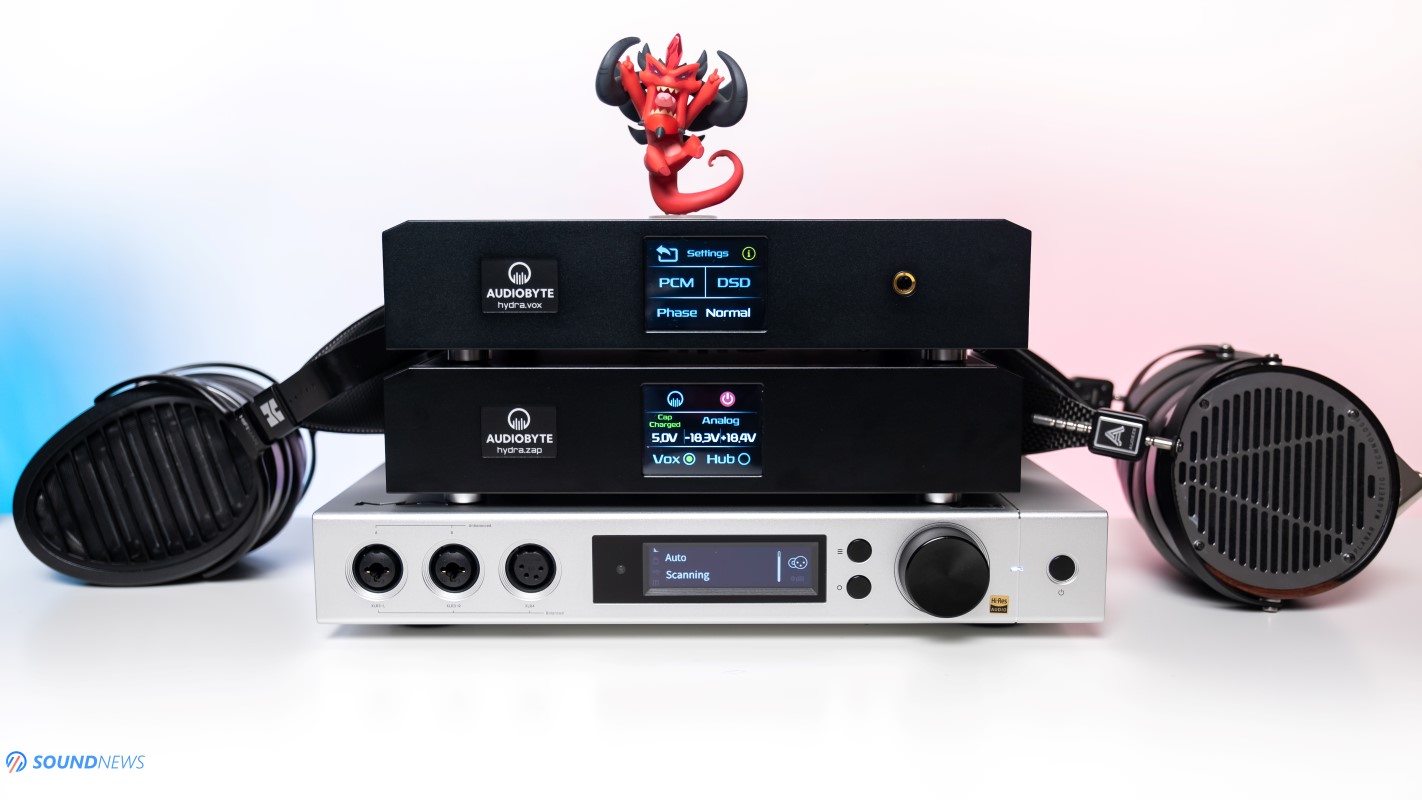
III. Resolution & Transparency
Here is the ugly truth, besides top-of-the-line Delta-Sigma (D/S) DACs, everything else like R-2R units that I have tested until this point were pretty good but not utterly amazing when it comes to resolution. Even the mighty Denafrips Venus and Audio-GD R7 (2020) while sounding super transparent and clean, were not offering the last bits of resolution that I so crave about. I know my music quite well, I know the mastering errors and all the micro-details in my mediocre-mastered music. Besides D/S DACs, everything else would hide a bit of truth or will simply “beatify” my music, applying a smoothing filter that would hide away part of said errors and small details and I don’t really want that. I’m super happy to report that Vox is not doing that at all. Vox is a brutally honest source, everything will be heard and felt will your whole body and eardrums. Thanks to its fullness and very textured approach, I am actually feeling those tiny details less bright and less blinding if you will. For example when Tom Morello presses his guitar pedal that subsequently engages the guitar amp on Bulls On Parade (Tidal / Spotify) , the noise feels more visceral, I actually felt it more real and weirdly enough, I liked that noise.
I like discovering new things in my music, I am always on the hunt for new details and for that a true magnifying glass like DAC will be needed. This is actually the first FPGA DAC that challenges my Reference Matrix Audio Element X in terms of micro-details and plays exactly at the same level. This stuff is real and Vox knows how to impress a detail freak like myself.
Detail sometimes can be tiresome to experience, especially when there is a lot of digital glare at the top of the audio spectrum, Vox doesn’t have any of that. Thanks to its natural textures, it feels full inside not hollow as most of the D/S are sounding. With it you can listen to trebles, cymbals, snare drum hits and bells all day long and it would not tire you down.
Transparency is also at the highest levels and I could very easily walk through my music and analyze anything I want. Finally, there is another source that makes me analyze audio components quite easily like amplifiers without stressing myself too much. This is the first DAC I am placing at the same level with Element X when it comes to transparency and detail.
I went through all my old music like rock and all its sub-genres, I went through old electronic music and all those details that I grown-up with are still there, I’ve heard them crisp, precise, a bit more textured and more real compared to my own reference DAC.
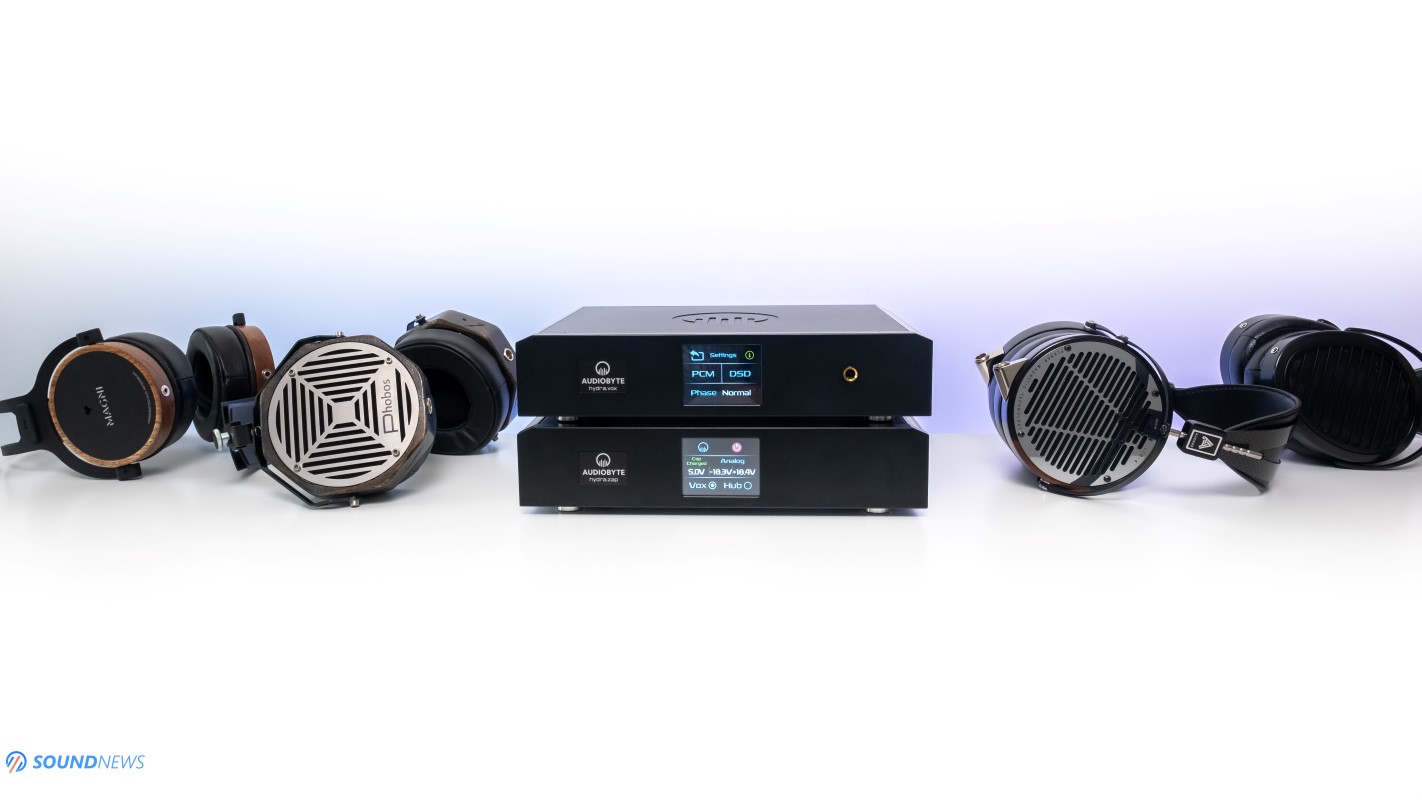
IV. Transient Response
Transient Response is an extremely interesting chapter. As you all know acceleration and speed of a car are both important and the same applies to digital sources. At first with no burn-in at all, it felt a bit slower but carrying huge amounts of air and slamming impressively hard. In time, from a slow heavy hitting source it transformed into a nimble fighter and a hard puncher.
I will again add the R-2R thing in the discussion. I personally like the texture of all R-2R units, the only two things I don’t like about them are: detail retrieval and transient response. Those were pretty good, but nowhere as clear and as fast and nimble as D/S DACs sounded, it is always a compromise no matter the technology being used. My reference Element X is an extraordinarily fast and nimble sounding source, but it loses a bit in terms of slam and how much air it can carry with every hit.
I’m very much into fast music, it represents me as a person, without an excellent transient-response, I will not toe-tap, I will not head-bang and will not be carried away by music. Vox is a true natural speeder and hitter, it moves huge amounts of air in a span of a nano-second, it is fast, nimble, hits fast and really hard.
I also want to point out that if I am connecting it to more powerful headphone amplifiers like Flux Lab Acoustics FCN-10 and Benchmark HPA4, the musical experience might transform into a masochistic experience where the thump would be felt extremely powerful but satisfying nonetheless. Same applies in a speaker-based setup, when it drove both the S125 and EX-M7 power amps, I’ve felt how S400 sounded like cannons, spitting some impressive dynamics in the process. As a DAC only device, Vox is simply the definition of transient response.
What more can I say, if it continues going like this, it might actually replace my actual reference source… My wallet is not prepared for this kind of damage.
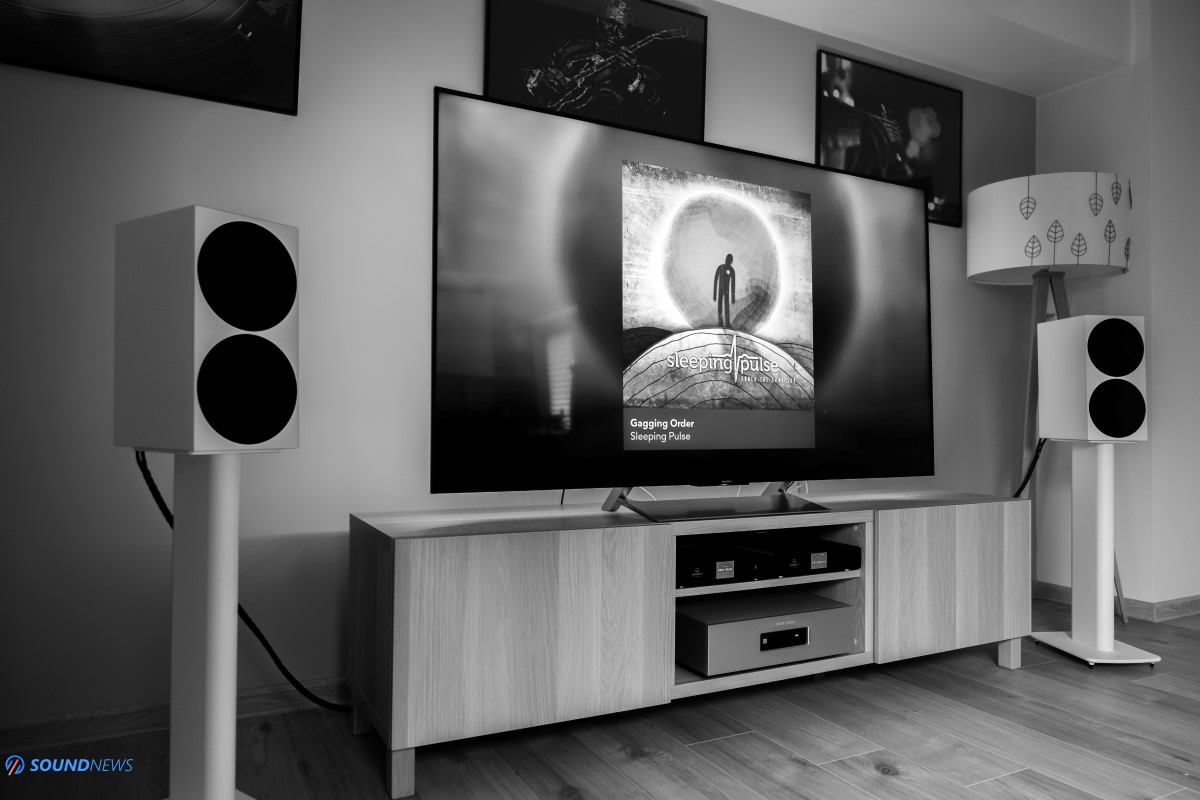
V. Soundstage & Depth
Most of this chapters are interconnected in one way or another. For example, soundstage and depth will always hang on its transparency as without it, music could not fly too far away sticking its wings in veil or mud. Soundstage and depth are also directly tied to how transparent and powerful is the output stage of a DAC. Vox employs four all-discrete bipolar based circuit boards working as analog buffer stages and as a direct result it offers an extremely transparent and airy presentation that will impress soundstage lovers even from the first seconds. With Vox, music flies far and wide, nothing is stopping it from hitting some imaginary walls. Some of the live music sounds absolutely impressive on all axes, even crowded music is easily decompressed to a point that it is no longer claustrophobic sounding. Even crowded rock and metal is slowly transforming into audiophile recordings, this might sound like some BS, but reality is that over-crowded music starts sounding a lot wider and separated, a lot of those distortions start sounding more textured and more real, in the end everything is more pleasing to experience, even distortion.
Sincerely, I didn’t even listen to my usual wide and deep sounding music, because when something is too obvious at first, you don’t need re-check what is already very clear from the start. The echo on The Innocent Man by Billy Joel (Tidal / Spotify) widens so much the soundstage level from left to right, that from a tall sounding Hifiman Arya, Vox is making it also wide and airy sounding too. I actually started listening to Hifiman Arya a lot more thanks to the decompressing nature of the Vox.
When I moved to the loudspeaker setup, I almost wanted to decrease the soundstage size, that airy presentation of the Vox plus that enveloping sound of the Buchardt S400 made my room sounding bigger in size than its actual size. Thankfully, the iron grip of the Vox plus of those two power amplifiers made S400 sound controlled, punchy and really tight. S400 can sound all over the place, mellow, slow and too gentle with the wrong setup, but not with this one and not on my watch. What can I say, I experienced the widest stage, one of the deepest presentations that easily outperformed the airy nature of my own Matrix Element X. HydraVox is incredibly open wide and deep sounding source and there is nothing more I can add.
If you love your music airy and breathing, if you like picking sounds from the air with your ears, if you like to enable your imagination with sounds coming from the back of your head and from multiple angles and views, then this is definitely of the nicest ones, I’ve experience so far, it’s The One to beat from now on.
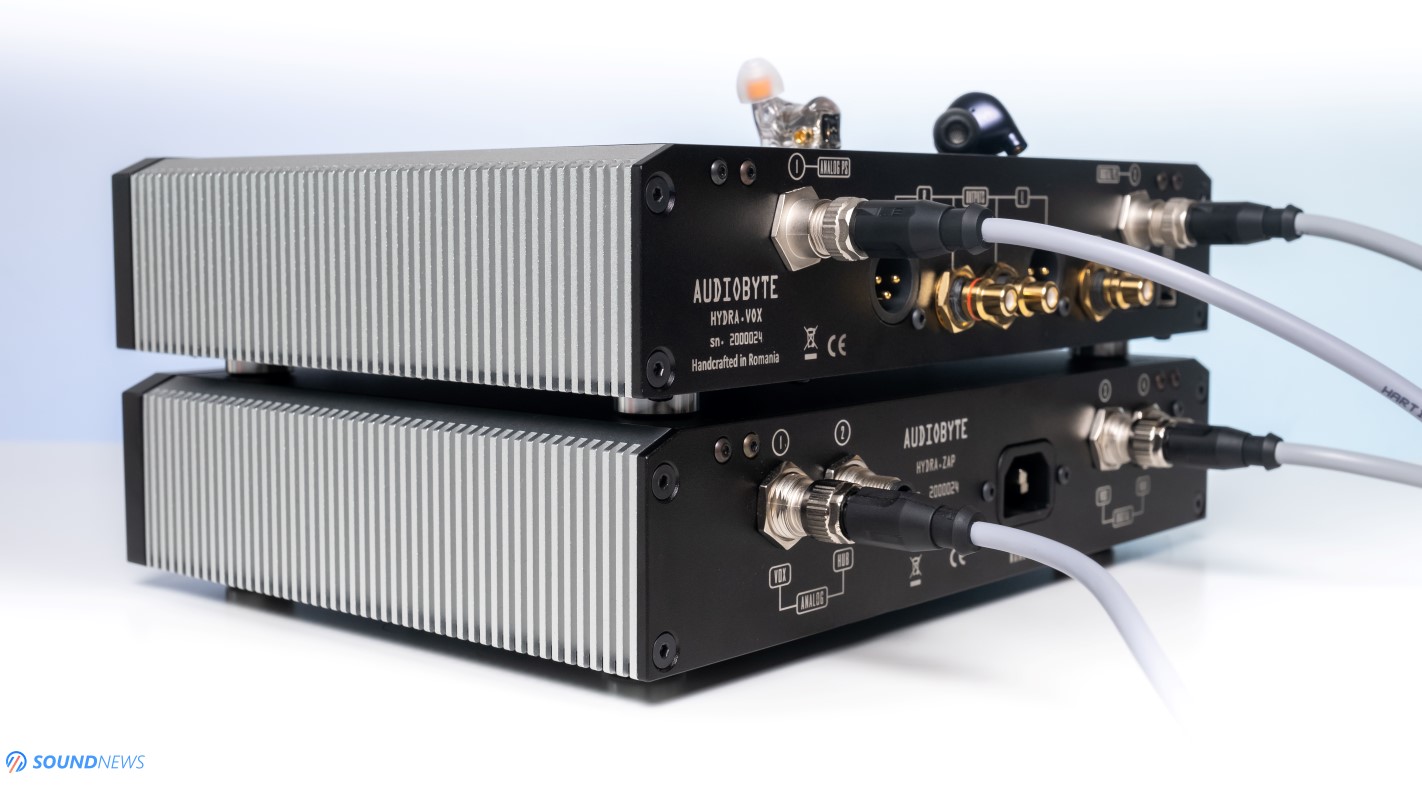
VI. Frequency Response
I will say it from the start: I hate EQ, I never use it and I’m against any DSP, I want my music as pure, as clean, as detailed but also as natural sounding as possible. I’m sticking to a linearity curve and I’m most impressed when nothing stands out and everything is evenly spread across the audio band. To this day, Element X followed my linearity curve and of course it is still doing that.
I’m not impressed when an audio manufacturer is boosting that low end but recess the treble, that is not cool, I want to hear everything there is, from the lowest pits of sub-bass to the highest treble peaks, I want to hear it all and when that happens, the hair on my hands will start raising.
There is not a single doubt in my mind that HydraVox powered by the HydraZap follows my very strict linearity curve. At first, I thought that it is another bold and impressive sounding source in the bass and midrange and only alright in the treble. But no, it is exactly what I am searching in a digital source. The thing is, its internal PCM to DSD conversion that happens all the time is bonding all those notes, it’s hard for me to express with words, you will need to experience that for yourself to understand. There is a silky-ness that makes even the top-octave tolerable and very pleasant to experience. The highest praise I can give is that the highest octaves are so crispy, defined, so incredibly detailed and yet completely grain and fatigue-free. I love it in there and I want all digital sources to have this trait.
The midrange is simply soul-grabbing, if there would be a definition of an ear-orgasm, then this is it. I have experienced a really natural, textured and high-contrast infused midrange. The goose-bumps that I experienced are happening often and no matter the song is being played, the tonality is always spot on. There is a right dose of naturalness in this one, but it will also impress a detail freak as myself. The pitch of all voices is so defined that the dynamic range felt wider in here. When a female and a male voice would clash in the same song, it almost feels like a competition, which one will impress you more. It is simply breathtaking in terms of midrange and no, D/S DACs can’t do this, I’m sorry, it is something else.
I’m still toe tapping you know, drumming for a short period of time in University left a small mark on me. I’m always hitting an imaginary double-pedal. I don’t know really why, but it feels good doing it and it is a sign that I am enjoying my time. I felt bass where normally I shouldn’t spot it, it was always defined, clear and probably a bit heavier in texture, but I loved it. Listening to some mediocre ‘90 music where everything was overpopulated with lots of bass notes, feels like listening to some drum-and-bass and to some wild rave. It has a powerful and defined low-end, it will impress a bass lover that is for sure. It is not over-done, it is simply very detailed, outlined and as such, it is much easier to look at it and experience its truest form and shape.
In terms of frequency response, Vox follows my linearity curve playing everything from 20 Hz to 20 kHz and passing this test with flying colors. Its defined and extended on both ends there isn’t more to say about this.
VII. A comparison
OK everyone, I think it is time to have a proper showdown between the best D/S DAC I’ve tried so far with the new contended in town. Ladies and Gentlemen, in the right corner sits the undefeated champion of the East – Matrix Audio Element X and in the right corner the fresh and young Audiobyte HydraVox, the new contender to the title of The One To Sit On My Desk!
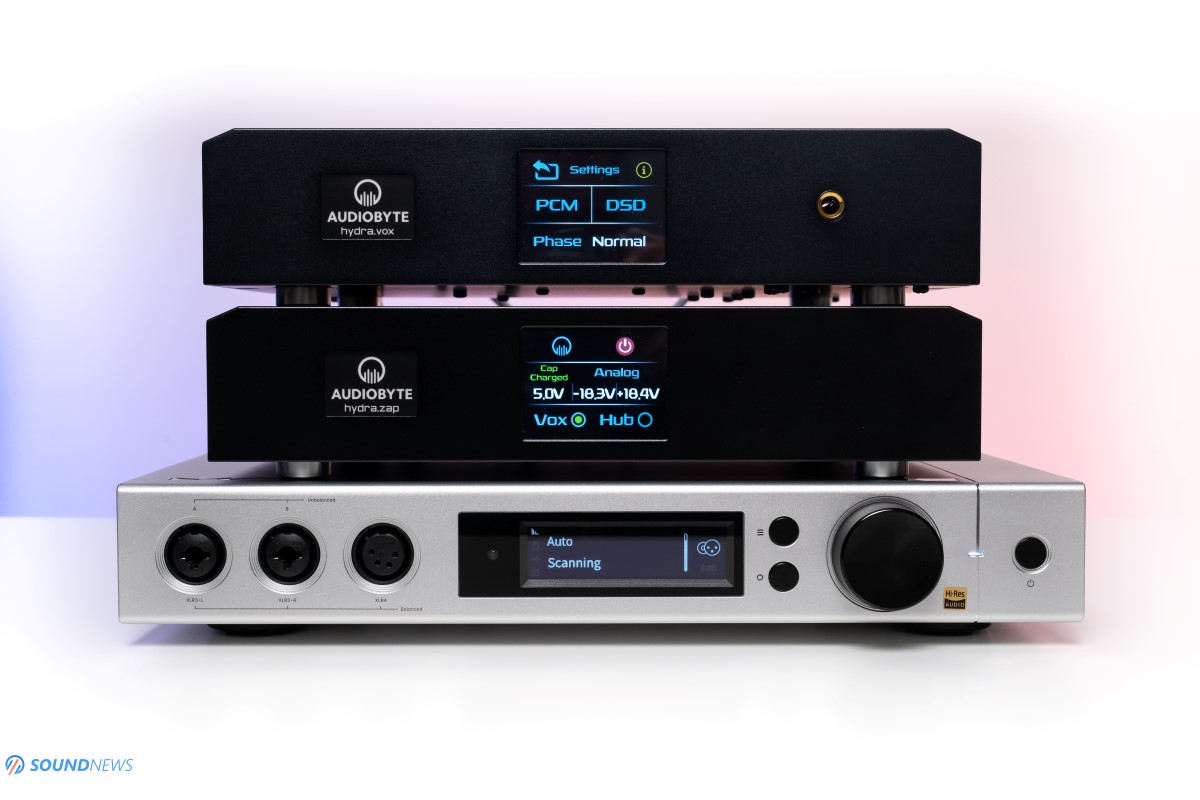
Audiobyte HydraVox + HydraZap stack (€3500) VS Matrix Audio Element X (€3000)
In terms of build quality, I find both equally pleasing, carved on CNC machines and having very tight tolerance numbers, they both feel and look like really expensive devices. Element X is one of the biggest D/S DACs I’ve tested so far and it is currently the best sounding as well, it is my reference up to this point. In terms of technology Matrix also put a headphone amplifier inside it, even a balanced headphone output but frankly the one inside the Vox is considerably more powerful and nicer sounding too. The one inside the Element X is op-amp based and its output stage was also made by using a combination of op-amps and discrete transistors.
Vox is all-discrete bipolar from input to output, without a single op-amp in the signal path. Audiobyte went really overboard with the power supply and filtering, you simply cannot have a better power supply that this one and when you give it a name, you know it is something special.
In terms of features they are both more or less the same, with the exception that Element X employs an interesting wireless streamer and music player plus a smartphone app integration that makes all that possible. You can add those features to the Vox as well with the upcoming HydraHub that should be released soon, but that will be extra expense.
The digital and analog sections are considerably more interesting and a lot more complicated on the HydraVox compared to Element X that uses a lot of off-the-shelf components, so in terms of technology, HydraVox is gaining a lot of momentum and distinguishes itself with its exemplary design and technology.
Before listening to them, I needed to volume match both units since Vox is outputting 3.8 V on the XLR (and RCA) and Element X a much hotter signal of 4.5 V. For that I used the MiniDSP E.A.R.S. and a 300-Hz sine wave. E.A.R.S. detected a difference of exactly 4 dB at the listening level of 85 dB with the Audeze LCD-4. I volume matched both units using the Benchmark HPA4 and commenced my listening session.
I will say it from the start that Vox stack sounds wider and deeper with all my music and that can be felt with both headphones and speakers. With speakers the difference becomes surreal as Vox is simply moving bigger amounts of air in the room and somehow infuses more texture and substance in all those notes. Vox has an invisible silk that is bonding all the notes, the music simply flows as a river and after switching back to Element X is feels like having a sharper leading edge but it stutters somehow, the flowing effect disappears and instead more grain is rushing in. Both units excel in term is frequency response and detail retrieval but they render it differently.
Element X has sharper and more defined leading edges, you feel them clearer, like the shell of those notes is more contoured, but the notes themselves are thinner and carry less air mass hurting the thump energy and punch into the chest. When you experience music in real life, you simply feel it with your whole body, you feel its texture, the insides of those notes. Vox is like that, highlighting more the texture, the mass of those notes and not only the contour. Vox is less sharp but considerably harder slamming, carrying absolutely the same amount of detail and information.
When it comes to headphones, as I said in the dedicated review of the Element X, it is pretty good, but not impressive in there. A dedicated headphone amp will perform much better, hence purchasing the Benchmark HPA4 later on. HydraVox stack by comparison feels more powerful and much fuller sounding too, Element X felt thin and lifeless via its headphone output, it is the only gripe I’ve had with that unit. With Vox I can easily live with that headphone output, as at -10dB the Audeze LCD-4 are already very loud, with 10 dB headroom left, reserved for high dynamic swings. With Element X I can easily reach 0 dB (max volume) with LCD-4 and still want a little bit more…
With loudspeakers I consider that both have very precise and really clean preamp sections so as preamps it is a tie. When it comes to DAC + Pre units, both performed admirably and putting dedicated preamps in a chain like this might not change that much.
All in all, HydraVox and HydraZap worked as a team outwitting and outmatching the old champion in all possible scenarios, except for detail retrieval and frequency response where I felt that both were performing at the same level. It is painful for me to write this, but HdyraVox is simply a better performing DAC and it will be the one to beat from now on.
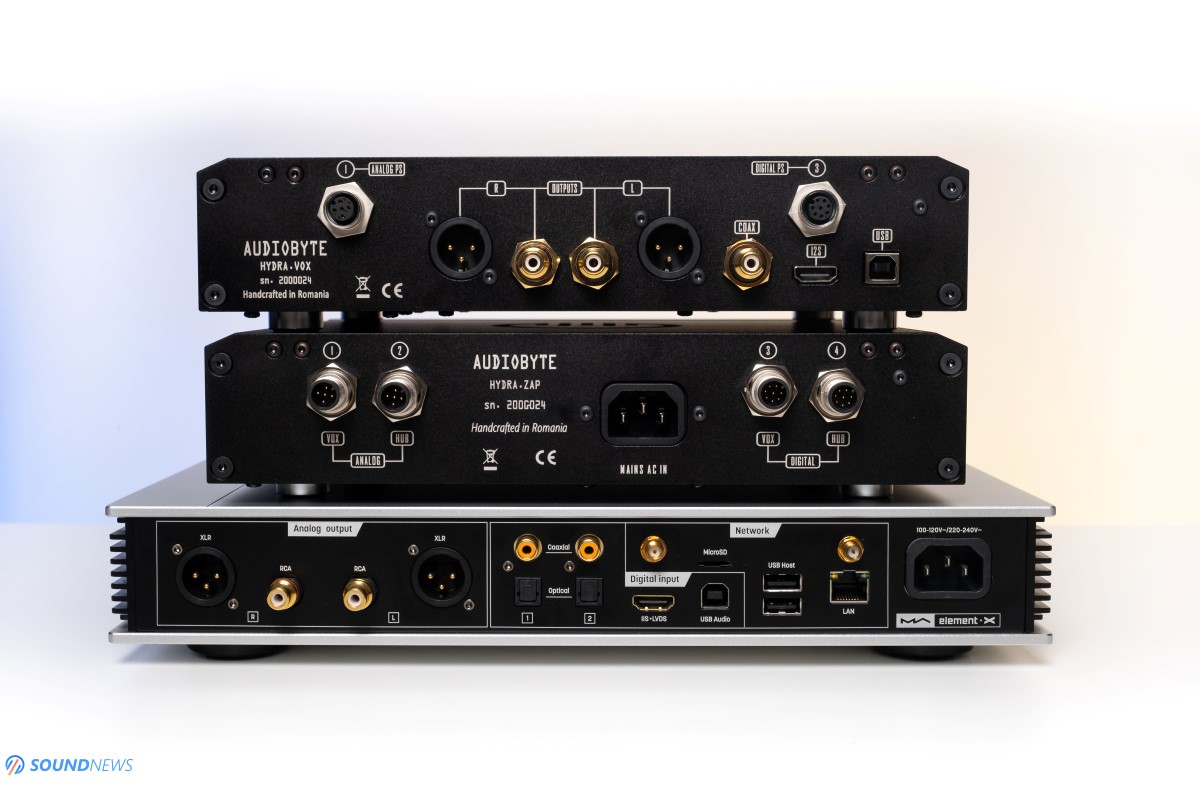
Conclusion
I’ve got a gut feeling that HydraVox might be shooting for a top spot in my rankings and frankly I was already expecting that. After popping the cases of both units and seeing all that cleverly arranged with top components, plus a FPGA silicon perfected for more than 3 years, my expectancy level from very high become out-of-space high. You can’t really go wrong after long research and development times especially if your name is Audiobyte or Rockna. Do also note that compared to most of the audio manufacturers out there, Rockna and Audiobyte are doing only Digital-to-Analog Converters, digital transports, servers, digital-to-digital converters, nothing more and nothing less. They are obsessed with digital and while listening to the Vox, I’ve felt that with my own pair of ears. HydraVox driven by the HydraZap is indeed a top of the line DAC that also happens to incorporate a great preamp section and a proper headphone amplifier.
I am told to hold my horses as the upcoming HydraHub upsampling streamer will increase the overall performance of the Vox stack by offering a much better clocking system and a direct path via I2S from the Hub straight to the heart of Vox’s Xilinx-7 FPGA. It will also add few additional digital inputs which is always nice to have. I’m also told HydraHub can’t do french fries, that’s a big bummer…Oh well, maybe its next version will.
Being at the top and offering outstanding sonics isn’t an easy task to achieve. HydraVox stack will cost you a serious sum of €3500. You can contact your local Audiobyte distributor for one right here.
Do I think it’s expensive? Yes. Do I think it is worth it? Totally.
This is the very first audio component to be awarded with our highest Golden Award! Congratulations to the team and I am looking forward to the HydraHub and to their next smart-devices.

PROS:
- Elegant and beautifully crafted devices
- Two box solution that will completely eliminate interference and balance the overall design
- Build quality is top-notch
- No remote? No problem! Audiobyte went with an app that works as a remote. Clever!
- Perfect channel balance and a very resolute 32-bit volume control
- Powerful and authoritative sounding headphone amp section
- Some of the best dynamics, slam and punch I’ve experienced in a DAC
- Very holographic sounding, excellent pin point location of all the notes, most 3D sounding source I’ve experienced
- Immaculate soundstaging capabilities, has an amazing depth too
- Linear and extended frequency response, follows my strict linearity curve
- Lighting fast transient response
- Great tonal balance, it sounds natural, life-like and full-bodied
- A drool inducing performance on all fronts
- It is one of the best digital sources I’ve experienced thus far
CONS:
- Slight hiss with uber-sensitive IEMs
- Expensive
ASSOCIATED EQUIPMENT:
- DACs: Audiobyte HydraVox + HydraZap, Musician Pegasus, Audio-GD R7 (2020 Edition), Flux Lab Acoustics FCN-10, Matrix Audio Element X, Burson Conductor 3X Performance
- Headphone Amps: Benchmark HPA4, SparkoS Labs Aries, Flux Lab Acoustics FCN-10
- Integrated Amps: Hegel H190, KECES E40
- Power Amps: KECES S125, Kinki Studio EX-M7
- IEMs: FiiO FA9, FH7
- Portable headphones: Sennheiser Momentum 2, Meze 99 Classics
- Full-sized headphones: Audeze LCD-4, Erzetich Phobos, Hifiman Arya, Quad ERA-1, Kennerton Magni, Kennerton Gjallarhorn, Ollo S4X Reference
- Loudspeakers: Buchardt S400, KEF LS50W
- Interconnects: QED Reference (x2), Aune AL3
- Speaker cables: Kimber PR8, Audioquest Type4
- Power Cables: Isotek EVO3 Premier (x2)
- Balanced Isolation Power Conditioners: PLiXiR Elite BAC400, KECES BP-600
